Think Cold Thoughts: Winter Containers
Guest Author: Susan Mintun
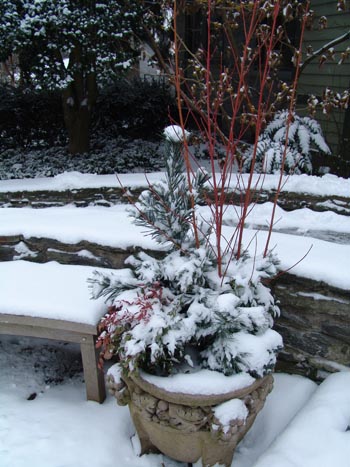 To take a break from the summer heat and in the spirit of this year’s plant sale theme, “It’s Not Finished with Fall!”, let’s take a look at a favorite garden design element that often gets overlooked in winter: containers. Many gardeners enjoy using containers to enhance their landscapes during spring and summer. But as the weather turns cool and the tender annuals and tropicals that have thrived for months begin to look sorry, many people think the only alternative is to empty and clean their planters, and put them away until spring. Or, if their containers are very large, they have to pull out the old plants and just leave a barren patch of potting soil sitting forlornly in the garden all winter. Not true! With a little planning, your containers can be beautiful all year. Below are a few guidelines for creating striking winter containers:
To take a break from the summer heat and in the spirit of this year’s plant sale theme, “It’s Not Finished with Fall!”, let’s take a look at a favorite garden design element that often gets overlooked in winter: containers. Many gardeners enjoy using containers to enhance their landscapes during spring and summer. But as the weather turns cool and the tender annuals and tropicals that have thrived for months begin to look sorry, many people think the only alternative is to empty and clean their planters, and put them away until spring. Or, if their containers are very large, they have to pull out the old plants and just leave a barren patch of potting soil sitting forlornly in the garden all winter. Not true! With a little planning, your containers can be beautiful all year. Below are a few guidelines for creating striking winter containers:
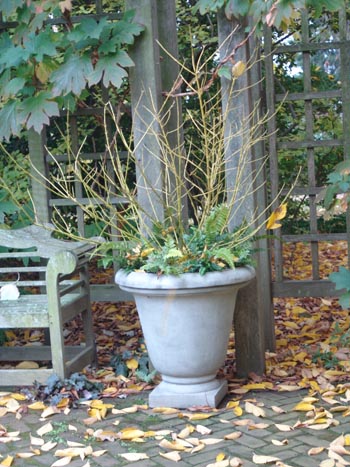
This large container allows for a large soil volume which helps to insulate plants from the winter temperatures. photo credit: R. Robert
Choose the right type of container: Opt for materials that can tolerate freezing and thawing without cracking. Wood, cast iron, polyurethane, and fiberglass are good options. Plastic can also work, but many plastics degrade and become brittle when exposed to UV light. Use large containers, 14” in diameter or larger, if possible. Greater soil volume protects roots, and since you will more likely be viewing your gardens from indoors, bigger pots will have more visual impact.
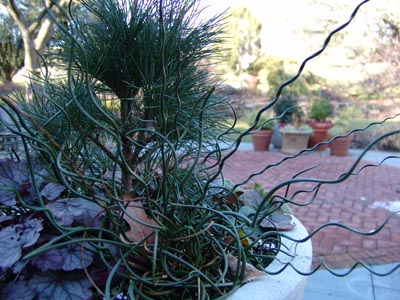
There are a wide variety of plants with unique textures and colors to fill your winter container. photo credit: R. Robert
Plants: Because the roots of plants in containers are more exposed to the cold than plants in the ground, a good rule of thumb is to choose species that are hardy 1 to 2 zones colder than our zone in southeast Pennsylvania. (Do you know our hardiness zone according to the adjusted USDA map? Swarthmore is zone 7A.)
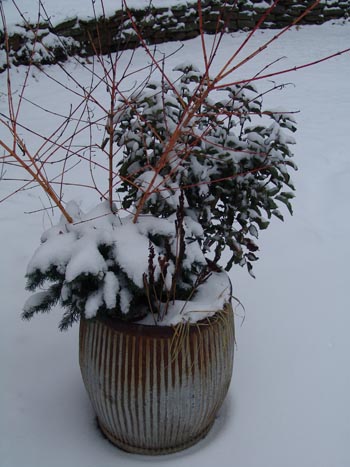
The cut stems of the redwood dogwood add a pop of color to this winter container. photo credit: R. Robert
Design: Unless your goal is a minimalist design, plant abundantly. Growth will be much slower from November through March, so it is not necessary to leave room for the plants to fill out. Don’t forget that you can mix cut plant material with living plants to create beautiful outdoor arrangements. Use branches of conifers and hollies or twigs of deciduous plants with beautiful bark, fruit, or architecture to fill out your design. The Holiday Greens Sale at the Scott Arboretum is an excellent source of cut stems.
Care and Maintenance: If possible, plant in early fall while the soil is still warm, (soil temperature above 40° F) so roots will still be actively growing, and can become well established. Don’t forget to water! Watch the weather forecast, and water before an anticipated heavy freeze (air temperatures 28°F or lower): moist soil freezes more slowly and retains more heat. Do not fertilize until active growth begins again in the spring. When spring finally arrives, you can opt to move your winter container plants into the garden, or to leave them in place and incorporate your spring flowers around them.
It really is that easy! The containers you will find on campus, particularly in the gardens around the Arboretum offices, can be a great source of inspiration. If you have never planted a winter container before, give it a try this year. We are featuring an array of wonderful winter container plants at the 2013 Scott Associates Plant Sale to help you get started.
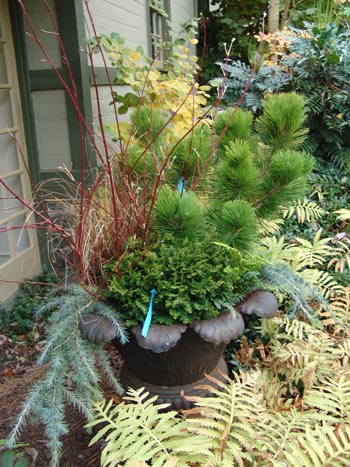
This winter container adds great interest throughout the cold winter months in the Scott Entrance Garden. photo credit: E. Haegele
Susan Mintun is a transplanted teacher and horticulturist who moved to Philadelphia in 2011. She served on the faculty and curated the plant collections of the Horticulture Department at Meramec College in St. Louis for many years before her husband’s job brought them back to this area. She holds undergraduate degrees in Fine Art, Business and Horticulture, and a Master’s degree in Plant Science from Washington University in St. Louis. Susan is thrilled to be back in the city where she grew up! She is enjoying rediscovering all the area has to offer and volunteering her time at the Scott Arboretum of Swarthmore College. She has two perfect children, both in college, the world’s best dog, and two spoiled cats. She and her husband, Mark, live in Villanova.





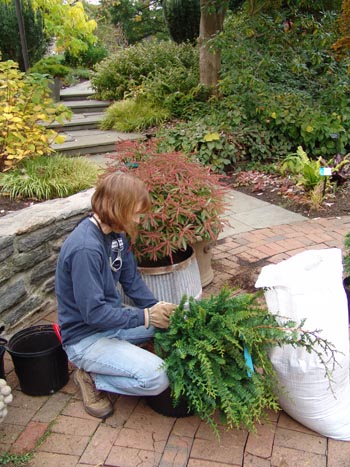

No Comments